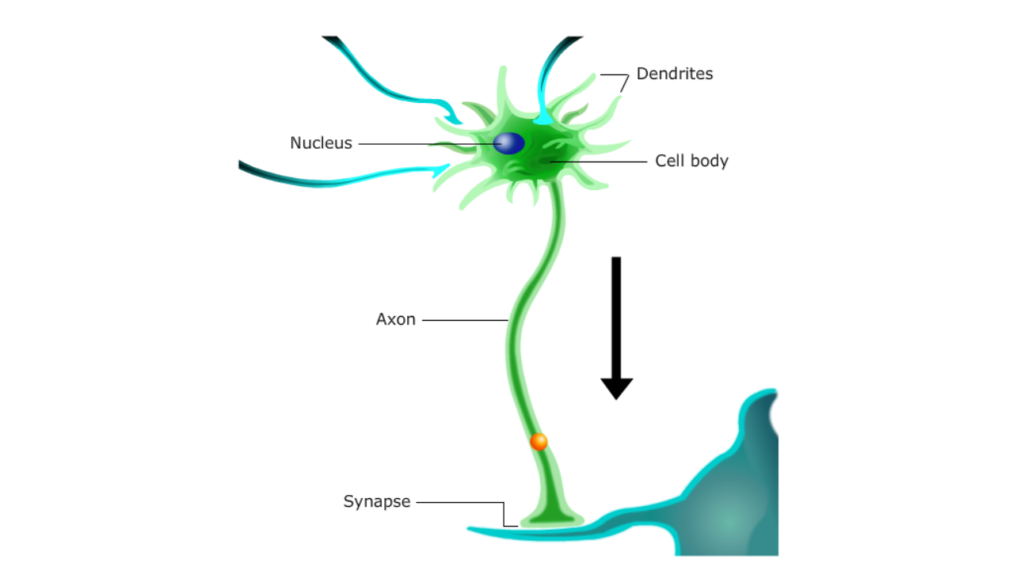TABLE OF CONTENTS
Neurohumoral transmission
Neurohumoral transmission implies that nerves transmit message across a synapse and neuroeffector junction by the release of humoral or chemical messengers.
The main events involved in neurohumoral transmission can be subdivided into-
- Axonal conduction
- Synthesis and release of neurotransmitter
- Receptor events
- Catabolism of neurotransmitter
1. Axonal conduction
Axonal conduction refers to passage of impulse along a nerve fiber. It is dependent on selective changes in the permeability of the axonal membrane to the electrolytes.

At rest the membrane potential is approximately – 85 mV in the axons. Electro negativity of the resting membrane potential is due to leaking of potassium ions against the concentration gradient from intracellular to extracellular.
An action potential reflects a reversal of the polarization state present at rest and is the result of permeability changes that occur at the axonal surface as an impulse is propagated along a nerve fiber.
A supra threshold stimulus initiates a localized change in the permeability of the axonal membrane. Suddenly, permeability of the fiber to Na+ is greatly increased in relation to K+. Na+ moves inward in the direction of its large electrochemical gradient.
The positively charged Na+ increases in concentration within the axon, the membrane potential moves from -85 mV towards zero and then overshoots to the extent that momentarily the inside of the fiber is positive in relation to the exterior of the cell.
Repolarisation of the membrane occurs rapidly as the selective permeability characteristics of the axonal membrane are quickly re-established.
The axon once again becomes relatively impermeable to Na+ and relatively more permeable to K+ and the negativity of the interior is quickly re-established.
Though the changes associated with an action potential are extremely short lived, they elicit similar alterations in membrane function in immediately adjacent quiescent areas of the axon.
Thus the action potential is self propagating and in this manner an action potential is conducted along the axonal fiber.

The axonal membrane is refractory for a brief interval after the passage of an action potential, thereby preventing antidromic and excess impulse traffic. Axonal conduction is insensitive to most drugs.
2. Synthesis and release of neurotransmitter
Depending on the type of innervation the specific neurotransmitter is synthesized and stored (in granules / vesicles ) in the nerve terminal. Release of the neurotransmitter substance is triggered by the arrival of axonal action potential.
Ca++ acts to link or couple the excitation of the membrane with discharge of neurotransmitter from the nerve terminal.
The sources of Ca++ are believed to be the interstitial space and/or superficial membrane binding sites at the axonal terminal.
The action potential initiates an inward movement of Ca++ into the nerve terminal from these sites.
Inward movement of Ca++ somehow triggers exocytotic discharge of neurotransmitter from the vesicles into the junctional cleft.
In contrast the neurotransmitter, nitric oxide is not stored in synaptic vesicles. Nitric oxide is highly lipophilic and it rapidly diffuses to effector cells. This nitric oxide formation is also activated by Ca++ through the enzyme nitric oxide synthase.
3. Receptor events
After rapid migration of neurotransmitter across the cleft, the mediator substance bind with the receptive areas on the pre or postsynaptic membrane. Receptor events caused by interaction of transmitter substance with the receptor may be of two general types, excitatory or inhibitory.
In excitatory response (EPSP-Excitatory post synaptic potential), there is a sudden depolarization of post synaptic membrane characterized by the net inward movement of sodium and eflux of potassium ions along their respective concentration gradient.
An (IPSP-inhibitory post synaptic potential) occurs when the neurotransmitter initiates a selective increase in permeability of the post synaptic membrane to only smaller ions (eg: K+, Cl–). The resulting hyperpolarization increases the threshold to stimuli and in effect elicits an inhibitory response to the cell.
Co-transmission
Co-transmission was believed that there is One neuron – One transmitter model which is an oversimplification. Many peripheral and central neurons have been shown to release more than one active substance when stimulated.
Cholinergic and adrenergic neurons elaborate ATP, Purines, Peptides, VIP, Neuropeptide Y, Substance P, Enkephalins and prostaglandins as co – transmitters.
Co – transmitter is not stored in the same neuron, but in distinct synaptic vesicles or locations. On being released by the nerve impulse, it may serve to regulate the presynaptic release of the primary transmitter and/or post synaptic sensitivity to it.
4. Catabolism of neurotransmitters
Norepinephrine is metabolized both by intraneuronal and extra neuronal enzymes. However the uptake of norepinephrine into the adrenergic nerve terminal and diffusion of norepinephrine away from the receptor sites are the important pathways of termination of activity.
Extraneuronal acetylcholine is rapidly hydrolyzed by acetylcholinesterase, a quite specific enzyme localised in close proximity to the synaptic cleft.
Nitric oxide is a highly reactive free radical that undergoes oxidation within seconds to nitrites and nitrates.
Note
Nerves releasing acetylcholine are termed as cholinergic and nerves releasing nor epinephrine are termed as adrenergic. In addition to these non-adrenergic non cholinergic (NANC) transmission also occurs. The transmitter responsible for transmission at NANC is nitric oxide. NANC has been demonstrated in gut, vas deferens, urinary tract, salivary glands and certain blood vessels. The supply to genitalia is parasympathetic, but acetylcholine is not the transmitter. It may be nitric oxide that is responsible for penile erection.